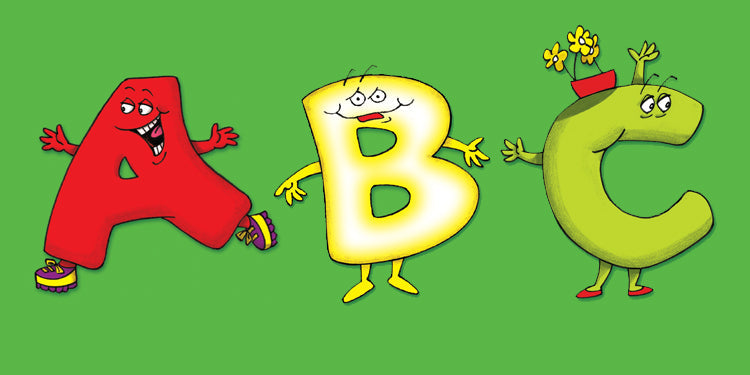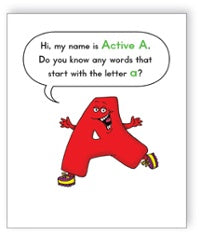 Mastering letters and sounds is a very important step in early literacy—it is one of the building blocks on which the rest of learning to read and write is built. Having the right activities and tools is crucial to success in teaching the necessary skills: letter-shape knowledge, letter-name knowledge, letter-sound knowledge, and letter-writing ability. With these skills in their repertoire, the exciting world of reading begins to open to students!
Mastering letters and sounds is a very important step in early literacy—it is one of the building blocks on which the rest of learning to read and write is built. Having the right activities and tools is crucial to success in teaching the necessary skills: letter-shape knowledge, letter-name knowledge, letter-sound knowledge, and letter-writing ability. With these skills in their repertoire, the exciting world of reading begins to open to students!
In order to read a word, a learner must be able to recognize the letters in the word and associate each letter with its sound. The goal is for the learner to be able to make the sound of each letter when shown the letters, think of more than one word that begins with each letter sound, name the letter that makes each sound when given the sound, and name the letter that a word begins with when given the word.
The more tools you have in your toolbox to expose students to letters and their sounds, the easier your students will find success. This post will cover some available tools and offer some ideas from the Letter Buddies teacher's guide on how to use them. The lessons can translate to a wide variety of similar products, but we use our own as an example here.
To begin with,
Letter Buddies Letter Books
provide the opportunity for exploration of the four elements of letter knowledge. Each letter book introduces six experienced-based vocabulary words that begin with the same initial sound. This series is an excellent resource that will help your students begin to make connections between letters, sounds, and words.
Several sets of the letter books will allow you to provide powerful letter instruction in your small groups. One benefit of the Letter Buddies Letter Books is that they can be “read” with minimal guidance and are often some of the first reading experiences for emergent readers.
Front Cover
- Use the illustrated scene at the top for great oral language warm-up and storytelling activities.
- Begin by introducing the Letter Buddy (e.g.: explain what ‘active’ means in the A book) and tell the children that the book will have pictures that begin with that letter.
- Have the children name the pictures that they see at the top of the cover and get them to predict why they might be there.
- Direct the children’s attention to the textured uppercase and lowercase letter on the cover. Use verbal directions for letter formation. Have the children practice tracing over the textured letters several times while saying the verbal directions.
- Inside Cover – read the speech bubble above the Letter Buddy. Ask the children to point to each word while you read.
- Title Page – ask the children to trace over the letters again, saying the verbal directions to reinforce proper formation.
- At this point, you should select what your focus will be for the reading of the letter book.
-
- If your focus is to draw children’s attention to the sound the letter makes in the initial position of the word (letter-sound knowledge), you would use language like this as you introduce each page:
- “This is a ____________ .” (name the picture)
- "This word says __________.” (point to the word as you say it)
- “Can you hear the _________” at the beginning of _________ ?” (say the sound of the letter and then the word, putting emphasis on the initial sound)
- “Say __________ .” (child says the word slowly)
- "Show me the __________ .” (say the sound of the letter)
- "Good. _________ begins with __________.” (name the word and the sound)
- Continue this procedure for each of the six pictures in the letter book.
-
Activity Page – This activity is the same through all the books. Once you have demonstrated what to do, children can practice and review independently or in pairs.
Back Cover
- All the Letter Buddies are presented in alphabetical order providing more opportunities for conversation and practice.
- Have the students locate the Letter Buddy for the particular book you are working with.
- Have the students locate other Letter Buddies they know.
- Have the students name the letters in alphabetical order.
 To cover the topic more in-depth with your students,
repetition and thorough exposure
are key. The
Letter Buddies Starters
series was developed to accompany the
Letter Buddies Letter Books
. In this series, the same six vocabulary words introduced in the Letter Books are used in a simple story, placed within the context of a sentence. PreK–K sight words (based on the Dolch list) and repetitive sentence stems are used throughout each story to provide young readers the opportunity to
practice and develop early reading behaviors
.
To cover the topic more in-depth with your students,
repetition and thorough exposure
are key. The
Letter Buddies Starters
series was developed to accompany the
Letter Buddies Letter Books
. In this series, the same six vocabulary words introduced in the Letter Books are used in a simple story, placed within the context of a sentence. PreK–K sight words (based on the Dolch list) and repetitive sentence stems are used throughout each story to provide young readers the opportunity to
practice and develop early reading behaviors
.
Following is an example of how you can lead a guided reading lesson using the Starters. In your small group, give each child a copy of Look at Me! (Starters Book – L). You will also need a copy of the Letter Book L.
Introduction
- Engage children in a short conversation by naming things on the cover: “Remember when we looked at Loud L’s letter book and talked about the things that begin with ‘L’? Today we have a new book. It’s called Look at Me! In this story we’ll see the same things we saw in Loud L’s letter book. Let’s look at the front cover and find them!”
- Introduce the sentence stem in the story: “In this book, Loud L is going to ask us to ‘look at’ these things.”
Title Page
“Let’s turn to the title page and read the title together. Make sure to point to each word while you read.” (Develop early reading behavior: one-to-one matching)Page 2
- “What do we see in the picture?” (Use the picture to support meaning)
- “Right, it’s Loud L and a lion. Loud L wants us to: Look at the lion.” (Reinforce the introduced sentence stem)
- “Let’s point and read this page.” (Practice one-to-one matching)
- “Good, I like how you pointed to each word as you said it.” (Reinforce one-to-one matching)
- “There’s a word you know on this page...‘the’. Can you point to the word ‘the’?” (Prompt for an early behavior: locating a known word)
- “Good! It helps when we look for words we know when we read.” (Explain why certain reading behaviors are helpful: recognizing sight words)
Page 3
- “Here’s Loud L with a lamb. Let’s read about it.”
- Children read.
- “How did you know that word was ‘lamb’?”
- Child responds that the picture shows a lamb and points to the word saying it starts with ‘l’.
- “Good noticing. It helps to look at the picture and check the first letter of a word we’re not sure of.” (Reinforce crosschecking behavior)
Pages 4–6
Continue a similar conversation across pages 4-6, encouraging children to check the picture, then identify the first letter of the word and its sound.Page 7
- “What does Loud L want us to look at on this page?” Child answers ‘lips’.
- “How do you know it’s lips?”Child talks about how Loud L is eating the lemon and lemons are sour.
- “Good prediction.”(Comprehension strategy)
- “Let’s run our finger under that word. Does it look like it says ‘lips’?”(Say word slowly to reinforce visual checking of whole word)
- “Right, it is ‘lips’ and I like how you checked the picture and the word.”
- “Let’s look at the end of the sentence. Here’s the exclamation mark we’ve seen in our other books. How do you think we’d read this sentence?” (Read punctuation to enhance fluency)
Follow-Up
- “Now turn to the beginning of the story. I want you to read Look at Me! by yourself. Remember to point to the words while you read and check the pictures and the first letter of each word.
- Children read the story.
Activity Page
- At the end of the lesson, ask the children to turn to the last page of the book—the activity page. Demonstrate how to create the next page of the story. As the children begin this task, you can move on to work with another group.
This is only the first installment in a three-piece series on how to teach letters and their corresponding sounds to emerging readers. Check back tomorrow for more lesson ideas! If you're interested in learning about other early literacy products, you can click below to request our catalog or download a one-page series overview on the Letter Buddies Letter Books .
- Tara Rodriquez


























































